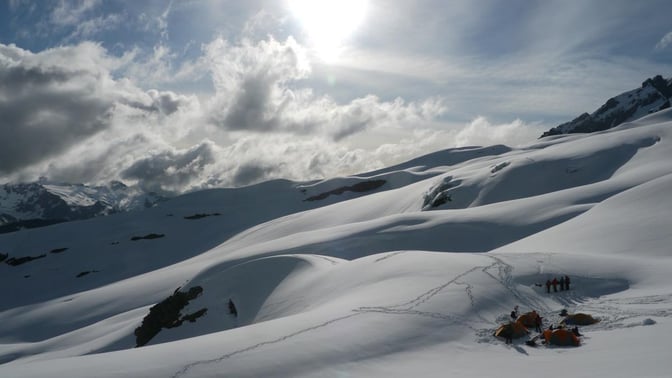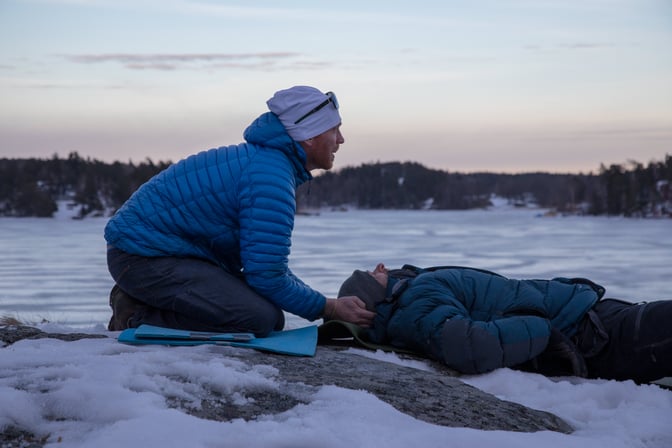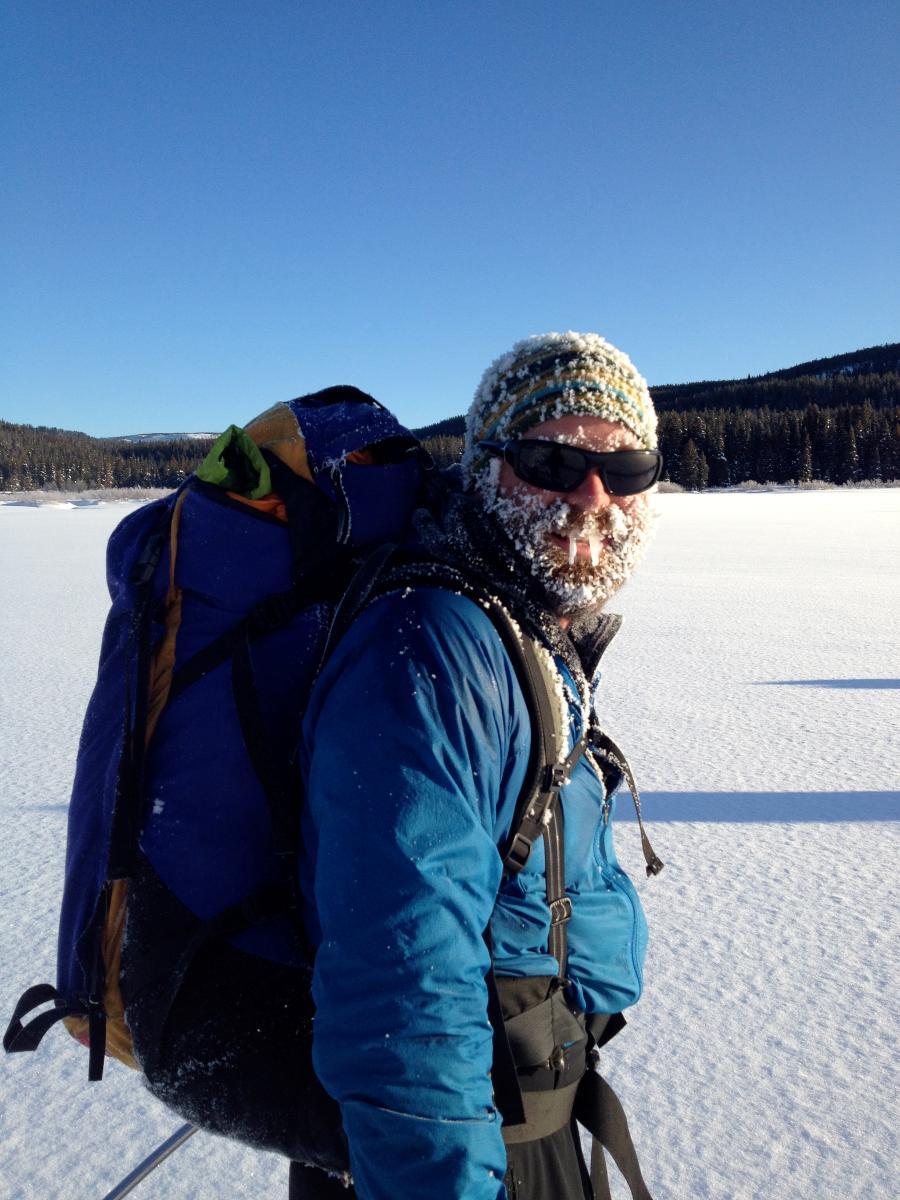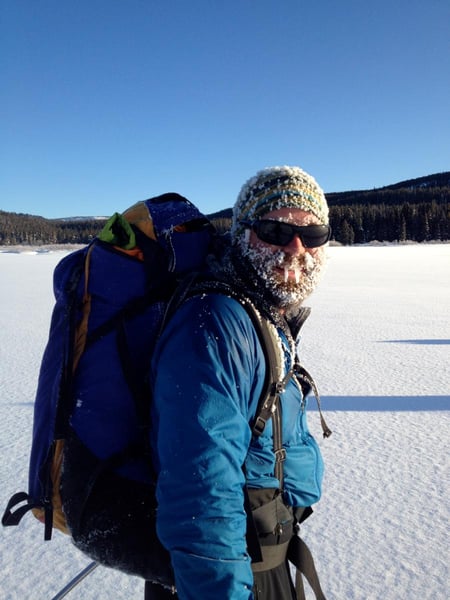Navigating rugged terrain isn't the only challenge when venturing into the mountains—long periods of cold temperatures and unpredictable mountain weather can pose dangers for the unprepared.
 Photo by Kyle Duba
Photo by Kyle Duba
For anyone who recreates outdoors, understanding the dangers of being exposed to cold temperatures for long periods of time, managing cold stress, and knowing how to prevent hypothermia is essential.
At NOLS, our wilderness medicine courses are designed to equip you with essential techniques for preventing, managing, and treating cold illness in remote mountain environments, from cold stress and mild hypothermia to moderate and severe hypothermia.
Emphasizing proactive measures to maintain a normal body temperature and conserve the body's stored energy, our courses prepare you for prolonged exposure to cold temperatures in mountainous environments.
Cold Stress vs. Hypothermia
In order to talk about hypothermia, it's important to also mention cold stress. Understanding the difference between the two can help when it comes to identifying the severity of the person's cold illness.
What is Cold Stress?
Exposure to cold temperatures for extended periods of time without proper protection can lead individuals to lose heat faster than their bodies are producing it.
Cold stress and hypothermia are related but distinct conditions that occur as a result of exposure to cold temperatures, affecting the body's ability to maintain its normal temperature. Cold stress is considered the body's initial response to prolonged cold exposure before hypothermia sets in.
What is Hypothermia?
Hypothermia is a progression from cold stress that refers to the cooling of a person's core body temperature to a temperature where normal brain and/or muscle function is impaired.
This condition impairs the body's natural mechanisms for maintaining a person's temperature, including the automatic responses and blood circulation patterns that help regulate heat within the body.
Unlike cold stress, hypothermia affects the body's internal functions and can be classified into mild, moderate, and severe stages, each with distinct symptoms.
If hypothermia progresses from mild and moderate symptoms to a more severe case after continued long-term exposure to cold environments without proper protection, it can lead to a decrease in heart rate, respiratory rate, and blood pressure.
How to Recognize the Signs & Symptoms of Hypothermia
 Photo by NOLS
Photo by NOLS
Recognizing the signs of cold stress and hypothermia in yourself and others, along with knowing the immediate measures to counteract these symptoms, is essential in halting the progression of hypothermia.
This knowledge is vital for those who work or recreate in remote and cold environments.
Cold Stress: The Early Warning
At this initial stage, characterized by a sensation of being cold and shivering, mental status remains normal, and the individual can usually take action to warm up and prevent further heat loss. This might include finding shelter (setting up a tent), adding layers of clothing, or increasing physical activity to generate more body heat.
Key Signs of Cold Stress:
- cold sensation
- shivering
- normal mental status
Mild Hypothermia: The Warning Signals Intensify
As the body continues to lose heat, it enters a stage of mild hypothermia. At this stage, individuals may start to find it difficult to perform complex tasks, especially those requiring fine motor skills.
Shivering becomes more pronounced, and other symptoms may include apathy, slurred speech, and "the umbles" — a term used to describe the combination of fumbling, mumbling, stumbling, and grumbling behaviors.
These signs indicate that the body is struggling to generate heat and that immediate action is necessary to prevent further decline.
Key Signs of Mild Hypothermia:
- impaired ability to perform complex tasks
- fine motor shivering
- apathy
- slurred speech
- “the umbles” (ex. fumbles to zip up a jacket, stumbles when walking, bumbles by dropping things, grumbles, mumbles, etc.)
Moderate Hypothermia: The Danger Escalates
Moderate hypothermia marks a significant escalation in severity. Shivering becomes uncontrollable and violent, and "the umbles" worsen, leading to more pronounced stumbling and an altered mental status.
These symptoms reflect the body's critical struggle to maintain warmth. At this stage, it's vital to seek emergency medical help while employing warming techniques, as the individual may no longer be capable of self-rescue.
Key Signs of Moderate Hypothermia:
- uncontrollable violent shivering
- worsening of "the umbles"
- increased stumbling
- altered mental status
Severe Hypothermia: Seek Immediate Medical Intervention
Severe hypothermia is a life-threatening condition where the body has exhausted its energy reserves, and shivering stops. Muscular rigidity sets in, and the mental status declines sharply, progressing to unresponsiveness. Pulse and respiratory rates decrease to the point of being hard to detect, and there is a risk of ventricular fibrillation, a type of heart rhythm that can be fatal.
Immediate medical intervention is critical at this stage to save the individual's life.
Key Signs of Severe Hypothermia:
- shivering stops
- muscular rigidity
- decreasing mental status that progresses to unresponsiveness
- decreasing pulse and respiratory rates that may become hard to detect
possible ventricular fibrillation
Strategies to Stop Heat Loss, Reduce Cold Stress & Prevent Hypothermia
To prevent hypothermia, especially in remote wilderness settings where immediate medical assistance might not be available, it's important to take preventive measures seriously. These strategies combine wilderness medicine principles with a preventive mindset, emphasizing the importance of preparation, self-awareness, and adaptability in outdoor environments.
Here are the top ways to prevent hypothermia:
1. Travel Together & Go Prepared
Traveling in groups or with a partner is highly advised over traveling alone, especially in extreme climates.
Before heading into the wilderness, inform someone of your plans and expected return time. It is also advised to carry an emergency kit. When traveling in cold temperatures, the emergency kit should contain thermal blankets, waterproof matches, a heat-reflective shelter, high-energy snacks, dry clothing, and a portable stove to warm beverages and food.
2. Wear Proper Clothing & Layer Wisely
Adhering to best dressing practices is essential to prevent hypothermia and minimize heat loss while recreating outside, especially in cold mountain environments.
Minimizing exposed skin, protecting extremities with gloves and hats, and using thermal blankets when necessary can enhance body insulation.
Materials like wool and synthetics are preferable for their ability to retain warmth even when damp, unlike cotton.
- Base Layer: Start with a moisture-wicking base layer, often made from materials like merino wool or synthetic fabrics, which is crucial for keeping the skin dry by pulling sweat away from the body.
- Mid-Layer: Add an insulating mid-layer, such as fleece or down, traps air to maintain body warmth.
- Outer Layer: The outer layer should be breathable to allow moisture to escape while blocking wind and water. This system can be adjusted based on activity level and weather conditions, ensuring optimal thermal regulation.
3. Stay Dry
Wet clothing and skin significantly increase the risk of hypothermia.
Replace wet clothes with dry clothes as soon as possible, wear moisture-wicking layers, and, if you step into cold water, dry off boots and socks as soon as it is possible and safe to do so.
Keep moving to increase body temperature after exposure to cold air while changing. You can use waterproof bags to keep spare clothing dry and understand the terrain to avoid unnecessary water exposure.
4. Stay Active, But Avoid Exhaustion
Again, when it comes to maintaining your core body temperature, it's important to keep moving. Simple exercises and movements can help.
However, don't overdo it. Fatigue can lead to poor decision-making and increased exposure to cold. Rest when tired, and avoid pushing yourself beyond your limits.
5. Use Heat Sources Wisely
External heat sources, whether chemical packs, proximity to a fire, or hot water bottles, can provide significant warmth.
The key is to apply these sources to the body's core or major arteries, which helps to warm the blood and circulate warmth throughout the body. Direct application to extremities should be secondary, as warming the core is most effective for overall temperature regulation.
6. Eat High-Energy Foods
The body's metabolism is like a furnace that needs fuel to generate heat. High-calorie foods act as this fuel, enabling sustained energy release and heat production. Consuming foods high in calories can help your body generate heat and raise the core body temperature.
Carry and consume energy-rich snacks such as nuts, chocolate, and energy bars. Foods rich in fats and proteins are particularly effective for long-term energy and warmth.
7. Stay Hydrated
Hydration is directly linked to the body's thermal regulation and overall function. Cold weather can reduce the sensation of thirst, leading to underestimated fluid needs. Moreover, dehydration thickens blood, impairing circulation and heat distribution, making you more susceptible to hypothermia.
Drink plenty of fluids. Though water temperature does not matter hugely, drinking warm fluids can both hydrate and provide an internal source of warmth, aiding in maintaining core temperature.
Treatment Principles: From Cold Stress to Hypothermia
When someone shows signs of mild hypothermia, immediate and proactive measures can assist in their recovery. Here's how you can help:
- Change the Environment: Seek immediate shelter to protect against the elements. A proper shelter, such as a tent, can significantly reduce the risk of cold stress and hypothermia by providing a barrier against the elements, including wind, moisture, and low temperatures. Utilizing a sleeping bag or pad adds crucial insulation from the cold ground, which can rapidly draw heat away from the body.
- Insulate the Patient: Wet clothing is a major heat thief; replace it with dry attire. Add layers that are windproof and waterproof for extra protection. Pay special attention to insulating the head, neck, hands, and feet. A Hypothermia Wrap (sleeping bag, ground pad, extra insulation, and windproof tarp) can significantly increase body temperature.
- Apply Heat Sources: Use heat packs or hot water bottles, ensuring they're insulated to prevent skin burns. Place them near the chest, armpits, and extremities for optimal warming.
- Increase Caloric Intake: Encourage eating to provide the necessary calories for heat production. Offer warm, sweetened liquids that are non-caffeinated and alcohol-free to aid in warming from the inside out.
- Encourage Gentle Exercise: If the patient is alert and able to stand, light exercise can help generate body heat.
- Be Mindful of Shock: Hypothermia can worsen shock conditions; keeping the patient warm is vital, especially in trauma cases.
- Rest and Recovery: Patients may need up to 24 hours of rest, hydration, and nutrition for full recovery.
Treatment Principles for Moderate Hypothermia:
If the condition worsens, the treatment strategies shift towards more intensive care:
- Gentle Handling: Prioritize handling the person gently. Move the patient as little and as gently as possible, maintaining a horizontal position to avoid cardiac complications.
- Prevent Further Heat Loss: Use the Hypothermia Wrap technique to conserve and gradually increase body temperature.
- Careful Heat Application: Similar to mild hypothermia, apply heat packs or bottles with focus areas being the chest, armpits, and extremities.
- Avoid Physical Exertion: Contrary to mild cases, do not encourage exercise as it may worsen the condition.
- Nutritional Support: If the patient is conscious and can swallow safely, provide calories to support internal warming mechanisms.
- Warm Oxygen: If available, provide warm, humidified oxygen to assist in internal warming.
Considerations for Severe Hypothermia
In the field, focus on preventing further temperature drop, supporting vital functions, and preparing for transport rather than attempting to warm the patient if hypothermia progresses to severe status. In addition to the above treatment principles, the following considerations should also be taken into account:
- Cautious Resuscitation: Avoid chest compressions unless absolutely certain of pulselessness, and be prepared for extended CPR durations beyond the standard 30 minutes, if necessary.
- Evacuation Guidelines: Any patient who does not show improvement with initial warming efforts or exhibits signs of severe hypothermia requires immediate evacuation to a medical facility for advanced treatment.
Implementing these treatment principles can greatly enhance the chances of survival and recovery from hypothermia. The key is swift action, careful monitoring, and ensuring the patient's warmth and comfort during the recovery process. Always prioritize getting the individual to professional medical care as quickly as possible in severe cases.
Be Prepared with NOLS Wilderness Medicine
Whether working or recreating in the outdoors, understanding how to prevent and manage cold-related illnesses and injuries is crucial. Don't let the unpredictability of cold environments put a damper on your adventures. Check out NOLS wilderness medicine certification courses today, and gain the skills, knowledge, and experiences needed to proactively prevent and, if it comes to it, treat hypothermia.
Written By
NOLS
NOLS is a nonprofit global wilderness school that seeks to help you step forward boldly as a leader.




